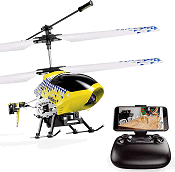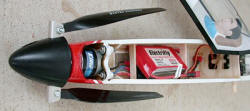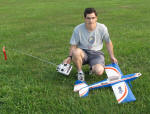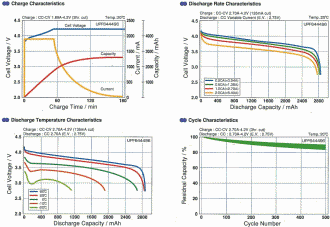Lithium-Polymer (Li-Po or Li-Poly) Battery Characteristics |
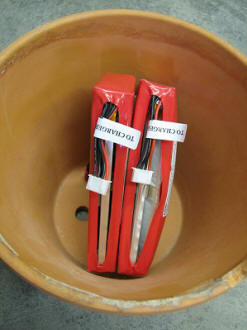
Above is a scary sight - a severely bloated Li-Po battery pack (next to an unbloated one). These two packs arrived in the same undamaged shipping container, but one looked like it was ready to explode - Scary! I took the photo and then put the pack outside in case it decided to self-destruct. Lightweight lithium ion polymer (Li-Poly) batteries have made a huge impact on the performance, and subsequently the acceptance of electric systems as a replacement for the traditional nitromethane (nitro) and gasoline power systems in model airplanes and helicopters. Their energy density (Wh/kg is the most common unit of measure), combined with the relatively new and extremely powerful brushless motors, electric power systems are rivaling the internal combustion systems in terms of both energy and duration. Development of both the brushless motors and the advanced battery technologies has been, both officially and unofficially, a joint venture between government and civilian research and development efforts. If you keep up with the news headlines for NASA, defense contractors, green energy researchers, and similar organizations, you have witnessed the plethora of new vehicles that have been built tested, and in may cased deployed in the field. These range from micro air vehicles that carry surveillance equipment for the military, to hybrid and fully electric passenger vehicles, vastly improved power sources for portable devices and equipment, and a whole lot of new products for the model enthusiast.
Events tailored specifically to electric-powered models have been created at the major contests worldwide, and some "electrics" are taking top prize positions in events where internal combustion engines are used in the same events as electrics. Energy densities of four to eight times as great as the older nickel metal hydride (NiMH) and nickel cadmium (NiCad) cells have been realized. Lithium technology has markedly improved flight performance and duration even with maintaining the existing brushed motors in the airplanes and helicopters. Some reports indicate that the use of electric power systems in model aircraft now exceeds the use of nitro and gasoline power. Model boat and car enthusiasts were easier converts because weight concerns are not as great.
One reason that electric power has gained so much momentum is the huge number of battery powered models that can be found in retail stores like Wal-Mart, Target, and Radio Shack, and of course online from Amazon. The Cox and Testors control line models of yesteryear using glow fuel (nitro) and the little 0.049 in³ internal combustion engines that once lined the shelves have given way to dozens of free flight and radio controlled airplanes and helicopters made of Styrofoam and come ready to fly out of the box - just charge and toss them into the air. Success is virtually guaranteed. For $30, you can buy a remote control helicopter that is more controllable by the novice flyer than the radio controlled helicopters I had back in the 1970s and even the 1990s. Many more varieties of electric powered airplanes and helicopter models (with differing degrees of complexity and cost) can be purchased at hobby shops and through online distributors.
Another motivation for the adoption of electric power is the nearly unperceivable noise emitted by them. As areas become more and more densely populated, finding and keeping an adequate flying site is increasingly difficult. Noise ordinances and nearby residents unwilling to tolerate the noise of the internal combustion engines have run off many modelers who used to enjoy being able to fly their craft. Now, with the "quite revolution" firmly in place, nobody even knows that you are flying unless they happen to see your plane in the air. The mostly irrational fear associated by the ignorant with the noise emanating from a nitro engine is utterly assuaged by the lack of noise coming from an electric. I say mostly irrational because in fact even the electric powered models can inflict a substantial amount of harm to a body or an obstacle upon contact. You can bet that I will not be to one to enlighten anyone (other than you, dear reader) as to the remaining potential for damage. Ignorance on the part of the layman is bliss on the part of a modeler desperate for a convenient place to fly.
As a side note, I will point out that responsible fliers of models are members of organizations like the Academy of Model Aeronautics (AMA), and therefore carry accident liability insurance. In the case of the AMA, I am covered for up to $2,000,000 (that's right two-million dollars) per incident. Another side note: Back in the early 1970s, whilst still a pup (about 14 years old), I managed to "land" one of my RC airplanes (an Andrews S-Ray, for those of you in-the-know) inside the local elementary school library one weekend. My radio system (on 27.195 MHz) and piloting skills were very bad at the time, and when combined with a gust of wind, my craft broke through the glass window. Even in my freaked-out mood, I found the courage to ride my bicycle over the principal's house and report the incident, and the AMA covered the cost of repair. OK, now that the very long and some might say unnecessary introduction to Li-Po batteries is out of the way, let us get down to the business of presenting some of the relevant technical facts.
Lithium-Polymer, abbreviated Li-Po or Li-Poly, evolved from lithium-ion (Li-Ion) chemistry. Li-Po cells are rechargeable, and if treated carefully, can have a lifetime of many years and can be recharged hundreds of times. The major distinction between Li-Ion and Li-Po is that the lithium-salt electrolyte is not suspended in an organic solvent as it is in the Li-Ion cell. It uses a solid polymer composite such as polyacrylonitrile (hence the "poly" for the electrolyte) as a physical separator, which reduces, but does not eliminate, the opportunity for internal shorting that can cause fires and explosions. Lithium, at atomic number 3, is a silvery white/gray metal that is highly reactive. Having an atomic number of 3 also accounts for its light weight. It is first in the series of alkali metals, and is the first solid element. Lithium reacts with and can catch fire in water and water vapor in the presence of oxygen. It also reacts with nitrogen, and since our air is 79% nitrogen, there is ample opportunity for a reaction in everyday use if the packaging is breeched either by puncturing or overheating. The video link above illustrates what can happen can happen to an overcharged Li-Poly battery pack. Pictures have been published in modeling magazines of the burnt remains of airplanes and helicopters whose owners did not properly recharge their batteries while the packs were still in the aircraft. The recommended procedure for charging the Li-Po battery packs is to remove them from the aircraft and place them in a fireproof container during the actual charging cycle. I use a clay flower pot as a container, with a metal plate below to cover the water drain hole, and a metal plate above with a weight on top of it. The charging cord rests in a notch that was made in the lip of the pot. Fortunately, after many recharges, I have never had a fire incident. Since lithium polymer (and lithium ion) are so sensitive to overcharging, the individual cells that make up the battery pack are charged independently. With NiCad and NiMH packs, the standard charging method is to apply a voltage and current across the series-connected cells so that the same current passes through each cell. The voltage across the entire pack is the sum of the individual cells voltages, but the cell voltages are not necessarily all equal. In fact, it is almost certain that they are not. Since nickel-based cells are relatively tolerant of some overcharging, there is usually no danger. It is not uncommon for one cell in a NiCad or NiMH battery pack to be dead, and yet the rest of the cells charge normally. What that means is in the case of an 8-cell pack, with the nominal voltage of each cell being 1.2 V (9.6 V total), if a charging voltage of 10.4 V is present, each cell would ideally receive 10.4 / 8 V = 1.3 V. If one cell is dead, however, the voltage across each cell would be 10.4 / 7 V = 1.5 V. That 15% increase can be handled by most NiCad and NiMH cells, but a 15% overvoltage applied to a lithium cells would eventually result in a failure, and likely a fire. Li-Po batteries are also intolerant of over discharging, and tend to die if discharged below around 2.5 V. In operation, controller circuitry should prevent the cell voltage from dropping below 3.0 V. Cell temperature should never exceed 90 °C in order to prevent the internal separator polymers from melting and allowing plate shorting through physical contact.
Early lithium batteries had a rather high internal resistance, and had rather low discharge rates. As with all technology that is doggedly pursued, significant improvements have been made to the point that the contemporary Li-Po batteries may be substituted in most systems for the original NiCad or NiMH batteries. Discharge rates of 20C or 25C are commonly available on the commercial market. In battery discharge terminology, each "C" is a discharge current equivalent to the value of the energy capacity of the cell (it is not the abbreviation for the Celsius degree unit). In the case of a 1,200 mAh rating, 1C is equal to a discharge current of 1,200 mA, or 1.2 amps. A 10C cell can deliver a continuous current to a load of 10 x 1.2 A = 12 A during its discharge cycle. The E-flight 450 motor shown to the right would require at least a 12C battery to deliver full rated power. This motor, by the way, is the one I use in my electric-powered sailplane (2-meter wingspan) and in my 4-channel aerobatic airplane (an E-flight Mini Pulse XT). In my humble opinion, lithium batteries are grossly overpriced, given the huge production volumes in effect. When you consider that almost every mobile electronic device and cordless power tool uses these batteries, the cost should be a lot lower. Maybe it is partially product liability insurance that manufacturers have to purchase that keeps the prices high, but I just paid $50 each for two 3-cell (11.1 V), 2,100 mAh packs. That is at least 2x to 3x what is should be costing at this point in the lithium cell evolution.
LiCoO2 + 6C --> Li1-xCoO2 + LixC6 Here is the discharge chemical reaction (from Quest Batteries): Li1-xCoO2 + LixC <----> Li1-x+dxCoO2 + Lix-dxC To the right are typical charge and discharge cycle charts for Li-Po batteries at room temperature (20°C). These particular charts are based on Sanyo data. Sanyo is currently the world's largest producer of lithium polymer batteries. As you can see, the cell voltage is reasonably constant out to about the 20% capacity state, and then falls off precipitously, similar to NiCad and NiMH cells.
There is a table of parameters for the most common battery types on the Battery Types & Specifications page here on RF Cafe.
Posted August 28, 2023 Related Pages on RF Cafe: - Li-Po or Li-Poly Battery Characteristics |

